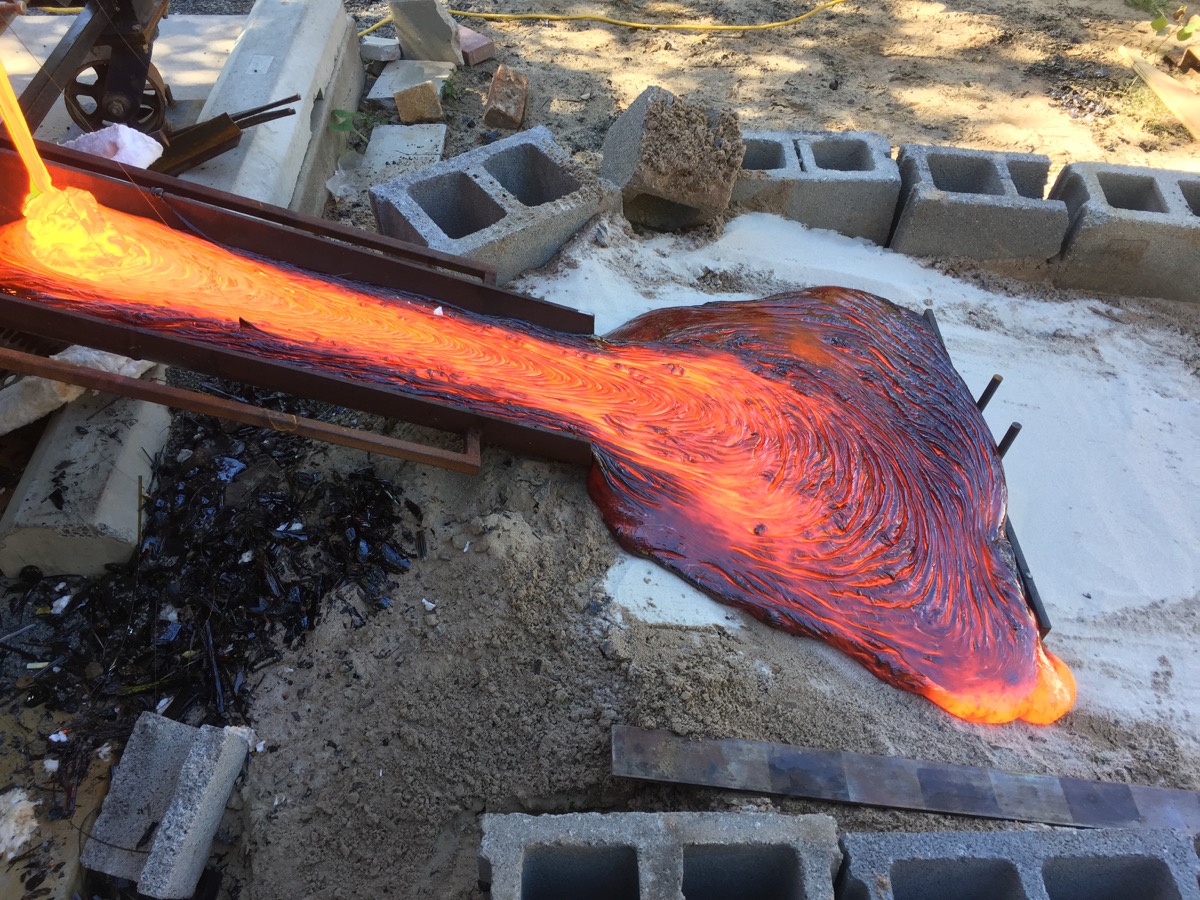Inside The Lava Lab, Burning Questions
6:18 minutes

 This story is part of our winter Book Club conversation about N.K. Jemisin’s book ‘The Fifth Season.’ Want to participate? Sign up for our newsletter or record a voice memo and send it to voices@sciencefriday.com.
This story is part of our winter Book Club conversation about N.K. Jemisin’s book ‘The Fifth Season.’ Want to participate? Sign up for our newsletter or record a voice memo and send it to voices@sciencefriday.com.
If you want to make a lava flow from scratch, the ingredients are fairly simple: one big crucible, and 200 to 700 pounds of 1.2 billion-year-old basalt dug from a quarry in Wisconsin. Combine these two, at 2,200 degrees Fahrenheit, and you have the Lava Project—a scientific study of the flow of molten lava in a Syracuse University parking lot.
Syracuse University geology professor Jeffrey Karson explains the work of the Lava Project and what captive lava can teach scientists about volcanic eruptions in the wild—all at a safe distance from the toxic gases, explosions, and other dangers of real volcanoes.
Take a closer look at the Lava Project and view the various flows and lava artwork in our Sci Candy feature.
Jeffrey Karson is a professor of Earth Science at Syracuse University in Syracuse, New York.
JOHN DANKOSKY: It’s time again to remind you about our fantastic Science Friday book club. This winter we’re reading N. K. Jemisin’s apocalyptic novel, The Fifth Season. It’s a story set in a world where earthquakes, volcanoes, and related disasters are constantly upending society. As usual, everything you need to participate is on our website. It’s sciencefriday.com/bookclub.
But in the meantime, we’re talking about geological turmoil whenever possible. And so it turns out that scientists studying volcanoes still have a lot of questions about them. One of the most basic ones, how does lava work? Does it flow down surfaces and what can its gnarled final shape say about the processes that it underwent when it was hot?
Here’s some difficult questions to study in the middle of, say, a volcanic eruption– more difficult to interpret from the long past geologic record. But at one lab in Syracuse, New York, a team of researchers found a safer shortcut. You just make your own lava. Here to explain more is Jeffrey Karson, geology professor at the University of Syracuse, principal investigator at the Lava Project. Jeffrey, welcome to the show.
JEFFREY KARSON: Good afternoon.
JOHN DANKOSKY: And we’ve got some gorgeous pictures of his lava lab, plus a write-up by digital producer, Lauren Young on our site. It’s sciencefriday.com/lava. So maybe you can set the scene for us. You’re pouring lava in a parking lot. What does this look like exactly?
JEFFREY KARSON: [CHUCKLES] Well, as unlikely as this may sound, especially for a place like New York where there’s certainly no active volcanoes and in fact no volcanic rocks in New York to speak of, basically we have this large furnace. It’s made for melting metals. And inside it, it has a large crucible that we put some ancient lava in. It’s about a billion years old. It’s old lava flows and all ground up into sort of gravel. It looks like it came right out of your driveway. And we heat it up with natural gas overnight. And then we pour it out to make new lava flows.
And we can do this under highly-controlled conditions. And we can, in very detailed ways, document that lava flow. And one of the interesting things and relevant to your show today is, it’s absolutely beautiful. And it has a very interesting and unique sort of texture to it.
People who are familiar with cooking and pour viscous sorts of materials, even like cake batter or to concrete– anything in-between there– will be familiar with the kind of general shapes that are made. But because the lava solidifies relatively rapidly as it cools, it freezes these beautiful dynamic shapes in this glossy black basaltic lava.
JOHN DANKOSKY: And as we say, we’ve got some pictures– sciencefriday.com/lava. I’m John Dankosky, and this is Science Friday from WNYC Studios. Where do you get the source material for this? Where do you get the stuff to make the lava that then you flow into the parking lot in New York?
JEFFREY KARSON: Well, we get our material from Wisconsin, actually, where there, a billion years ago, there was an ancient rift zone, very much like the East African Rift today. And there’s just loads of basaltic rock there. Basalt is the most common type of lava on our planet– in fact, on all the terrestrial planets and many of the moons in our solar system. It’s just black rock. It is not very sexy-looking stuff at all. But we just get it ground up. It’s used for road metal, and driveways, and all sorts of things. So it’s very inexpensive. And we can just put it in our furnace and melt it up.
JOHN DANKOSKY: Not all lava is created equal, from what I understand. There’s different types of lava. Some of it behaves differently than others.
JEFFREY KARSON: Absolutely. The main thing that governs the behavior of the lava is its composition, and specifically, how much silica is in the lava. But about 90% of the lava that we study on our planet and other planets is this black basalt. It has about 50% silica in it and an array of other atomic species are in there as well– aluminum, sodium, potassium, iron, magnesium, and so forth.
Different lavas have different proportions of those materials in it. That silica content makes a big difference. It controls the viscosity of the lava. There are also some other factors that are involved– the amount of water dissolved in the lava, bubbles that occur in the lava, crystals that develop in the lava. All of these things affect its viscosity, and hence the way it flows.
JOHN DANKOSKY: You’ve obviously been able to learn some things about how lava works by doing these experiments in your parking lot. What have you learned? What have you learned about lava that maybe you couldn’t have found out by going to a volcano site?
JEFFREY KARSON: Well, I can give you a couple of quick examples. One is that, as a geologist, you typically see these old lava flows. And we’d have to kind of guess what the erupting process was like. How do the lava move across the landscape? And of course, we’d like to know this in order to predict where active lava flows go and so forth.
But one of the things we’ve been able to do is begin to calibrate the shapes of the lava flows under different conditions. We make very different-shaped lava flows. And by experiments– doing these lava flows over and over again under different conditions– we can see the temperature, the rate of flow, and the kind of slope that different-shaped lava flows form in. So we can compare those to the lava flows, we see in nature.
Another interesting and more–
JOHN DANKOSKY: Yeah.
JEFFREY KARSON: [INAUDIBLE] sorts of things are–
JOHN DANKOSKY: And very quickly if you would. Go ahead.
JEFFREY KARSON: We also see huge balloons that form when water vapor expands rapidly. It blows bubbles in the balloon. And also we see that lava can sometimes hydroplane down slopes of wet material by making a vapor layer underneath it, sort of like an air hockey game.
JOHN DANKOSKY: Oh. See, that’s very cool. That’s something I wouldn’t have known about lava if you hadn’t have told me. Thank you. We’ve run out of time, but I’m so glad you brought us this story. If you want to see more about what we’re talking about go to sciencefriday.com/lava. Jeffrey Karson is a professor of geology at Syracuse University in Syracuse, New York. Thank you so much, sir.
JEFFREY KARSON: Thanks, so much.
Copyright © 2019 Science Friday Initiative. All rights reserved. Science Friday transcripts are produced on a tight deadline by 3Play Media. Fidelity to the original aired/published audio or video file might vary, and text might be updated or amended in the future. For the authoritative record of Science Friday’s programming, please visit the original aired/published recording. For terms of use and more information, visit our policies pages at http://www.sciencefriday.com/about/policies/
Christie Taylor was a producer for Science Friday. Her days involved diligent research, too many phone calls for an introvert, and asking scientists if they have any audio of that narwhal heartbeat.